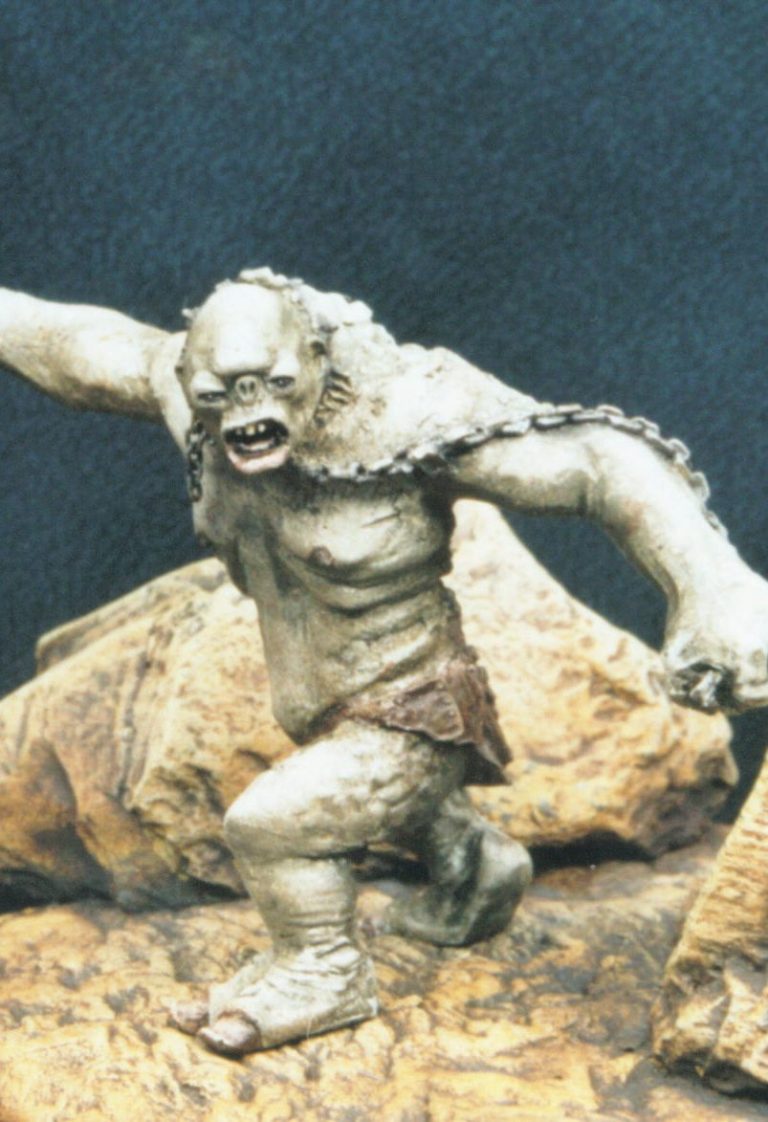
"They Have A Cave Troll"
28mm Games Workshop white metal figures
Painted by Thomas and Adrian Hopwood 2005
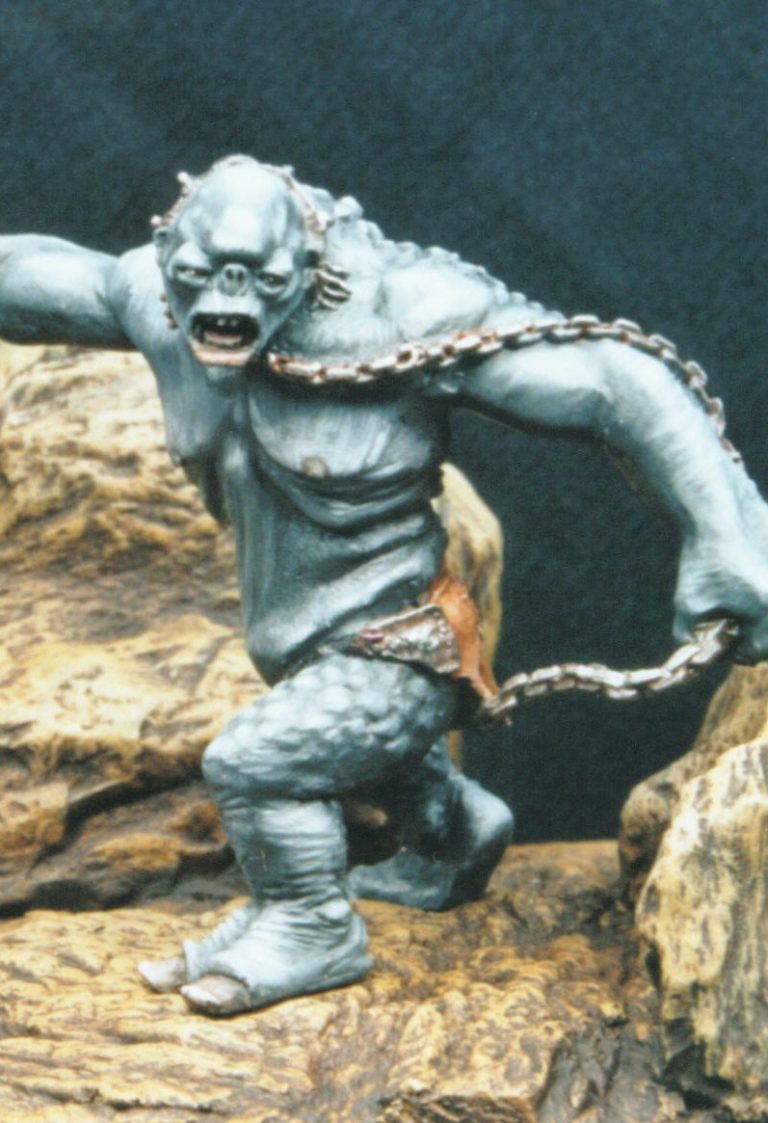
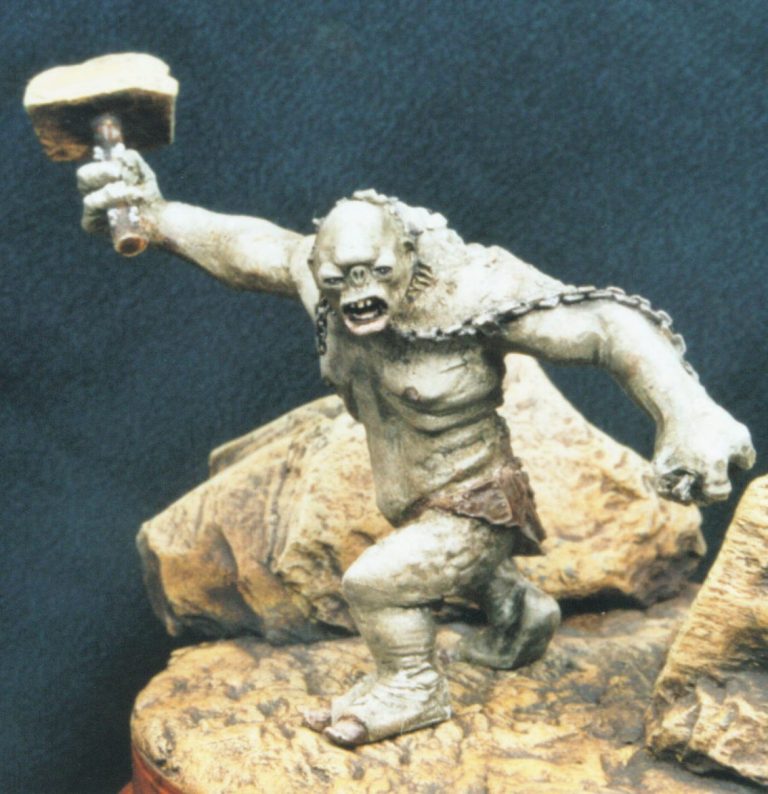
It’s my favourite one liner from The Lord of the Rings trilogy; Boromir taking a quick glance through the doorway of the room which holds Durin’s tomb in Moria, and in a sardonic, nothing can get worse tone, stating that “They have a Cave Troll.”
As my son gets more and more interested in modelling, and is refining his preferences as to what he likes to model, he’s not only improving his painting techniques, but also showing an eye for movement and anatomy. Granted he was only eleven at the time this was painted, and still suffered from the “WOW” factor quite alarmingly, but seeing that he has developed an eye for what he wants “to do” is pleasing in itself.
Slowly, and it’s been a long haul, I’ve managed to steer him away from just choosing models that I’ve got squirreled away on my shelves, to actually buying his own. This means that sometimes, Thomas and I end up with two of the same model.
In this case, although we don’t agree on which is the best of the three films (I prefer the first film, he likes the second one ), we do agree that the bad guys get all the cool looking stuff, and generally have more presence in model form.
When Games Workshop first released these, we both had to have one.
Admittedly, that was some time ago, but better late than never. We did start these before the last house move in mid-2004, and that did slow things down too.
Anyway, the models.
Both are identical kits of the Cave Troll from the first film, swinging a rather large hammer. The likeness is dead on to the film CGI character, and GW have actually gone back to realistic proportions for the LOTR figures. These are back to a true 25 — 30mm scale figure, having good humanoid proportions rather than the caricatured structure of the GW Warhammer World figures.


So that’s what we liked about the models.
What didn’t we like.
Well, the metal.
To be honest, and I’ve been working with white metal figures for the last 25 — 28 years, I’m not in the least bit impressed with the metal that GW are using now. It’s hard, brittle stuff that’s difficult to clean up, cut, sand and file, and it doesn’t seem to like any of the superglues or epoxy glues that I have in my stock. It’s also bloody hard to drill into
So O.K. I probably shouldn’t moan too much, after all I’m an experienced modeller, and should be able to cope. Yeah, right, but these are designed for kids from their early teens onwards, and it’s all very well showing them some great paint jobs, done by the experts, but if it’s hard for an old hand like me to get the results, then how’s it going to be for some poor spotty kid with few tools, no parental backup and little or no access to other means of help.
Perhaps this is why the plastic GW products are doing so well ?
But I digress.
The model’s good, but the material sucks. Enough said.
As for painting, well, we went for different looks. Thomas chose to follow the film colouration with his model, a sort of greenish tone, and I decided that I wanted to be different, and went for a more blue- grey scheme.
I’ll stress here, that whilst Thomas did ask for my advice several times during the build, the work on his model is all his own. I don’t touch anything that’s going to be entered by him in the juniors. I’ll give him advice, show him either with a dry brush or on a different model how to do something, but his models are his own work. I feel that he’ll learn better that way.
It’s also understood that he’s walking home from the first show that he beats me at — harsh, but fair!
The models come in several pieces, the upper body being separate from the legs / lower torso, the right arm is separate, as is the hammer head. A GW 40mm x 40mm plastic base is also included, but we didn’t use this.
After buggering about with various superglues, including GW’s own brand, I finally had to try epoxy glues, and eventually had to use some that I’d got from a friend at British Aerospace. Hence, I can’t really tell you what’ll fasten this stuff together, but it’s probably used to hold several parts of the Eurofighter aeroplane in one piece and in the air !
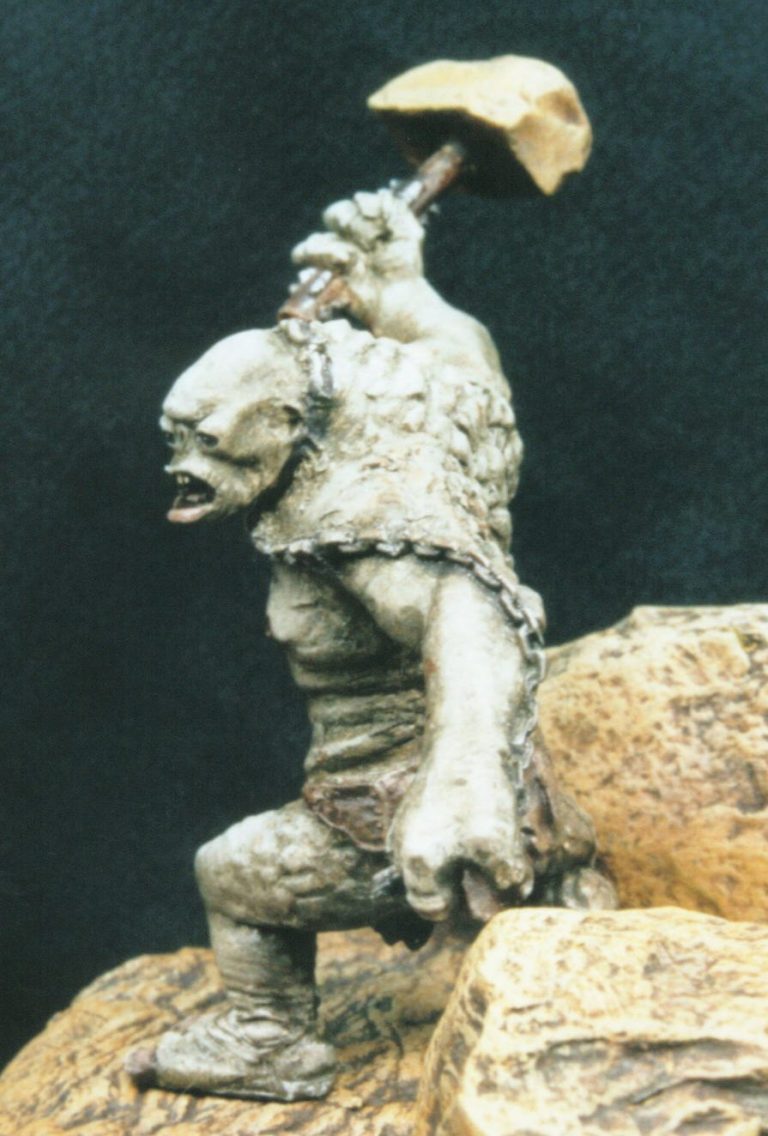
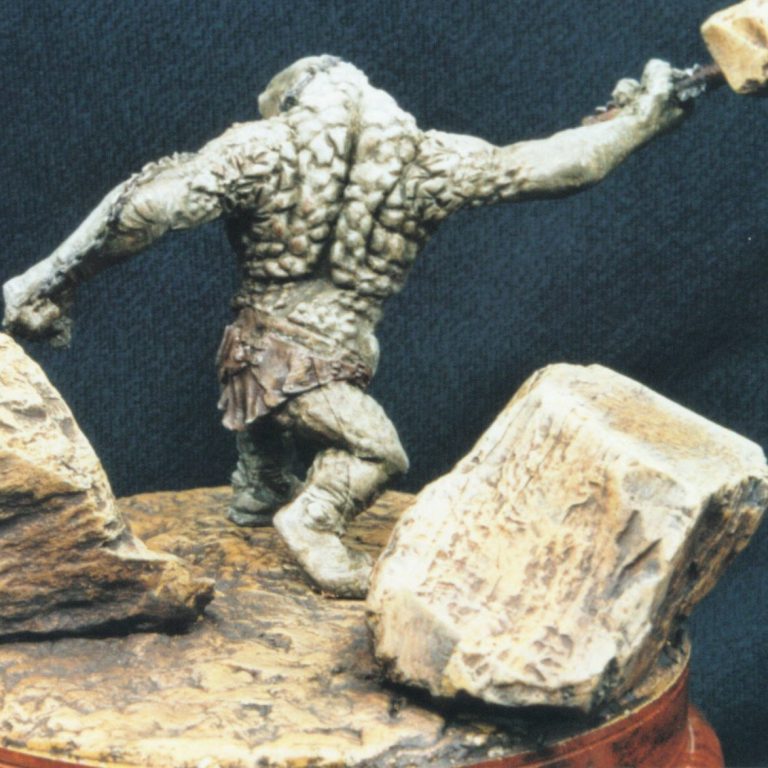
All the joints were pinned, as I still wasn’t confident that they would stay put.
There were some gaps too, and these were filled with Magic Sculpt epoxy filler, which I find to be finer and stickier than Milliput, and thus better for small gaps on figures such as this.
Both models were painted with oils over an acrylic base, and there’s not much to be said about it really.
The basics go like this. A primer / undercoat of Skull White acrylic from GW was used, mixing the first coat of this with some Isopropyl Alcohol so that it would flow onto the model and grab onto the metal once dry.
Over this we both added more coats of the Skull White so that after probably five thin layers of paint, the solid white colour was evenly coating the model.
This was allowed to dry overnight, and then we started with the oils.
I’ll detail Thomas’s here, as I paid more attention to how he mixed the paint up. The method used for its application though is basically the same, though I’ll go into more detail for the finer points of my model after this.
Basically a dark green mix was made from Mars Yellow, Prussian Blue and Chrome Yellow. By adding different amounts of the colours to the mix, and then trying it on small areas of the model, we came to the colour that Thomas wanted, and it would equate to around 3 parts of the Mars Yellow, 2 parts of the Prussian Blue and 1 part of the Chrome Yellow.
This mix was then painted all over the figure, paying attention to all the recessed detail. Thomas used an old brush for this, as the technique tends to take a toll on the bristles.
Once fully covered, the model was treated to a thorough cleaning with an old T-shirt, using this to wipe and dab off the excess paint so that the dark colour was left in the deeper creases of detail, but only a stain of it was left on the higher points.
Using a different brush now, one that was slightly smaller and dry, Thomas then began to add Titanium White oils to the model, using a dry-brushing technique that caused the paint to be left on the upper areas of detail. Because the green paint is still wet, this allows the two colours to mix slightly, and by adding more and more of the white gradually, the highlights are picked out.


Some detail painting was then done, again using the Titanium White and a fine brush, to highlight the different muscles and scales. I did more work on this part of my model, as I’ve either a lot more patience, or am a lot sadder than Thomas - depending upon your viewpoint ( “Dad, you’ve been on that bit for ages, can’t we do something different!”).
The other details could then be picked out once the skin was dry. These being the loin cloth, in dark leather colours for Thomas’s ( Burnt Umber / Mars Brown and Titanium White ) and lighter colours, because mine was the troll that followed them down the river and surreptitiously skinned that smart-arse Sean Bean when the rest of the company weren’t looking.
I used Mars Brown, some left over human flesh mix and Titanium White.
The metal areas were painted with the darker silver metallic that GW do, and I can never remember the name, and the label’s fallen off my tub of it. I mix it with more Chaos Black anyway, so does it really matter?
Whilst the dark silver is still wet, I added some Winsor and Newton Silver ink directly onto the model, blending the two colours together so that mid-tones and highlights are formed. Thomas tried to do the same, but his effects are a little coarser than mine. With practice though, he’ll soon master the idea.
The shaft for the hammer was painted with the same colours that Thomas used for his Troll’s loincloth, adding fine lines of the lighter colours to hint at wood grain.
Now at this point, I shall attest to having no part, knowledge, nor blame attached to me for the following argument. Somehow, and I have no idea how, we lost Thomas’s hammerhead. Now I know it was his that went missing, because my model, albeit at that point both were lacking paint, still had its hammer attached. (Mine was the one that had had the chain broken from around its neck - somehow).
Anyway, after much heated discussion as to who was getting the sole surviving hammer head, I showed Thomas how to use a small piece of coal as a substitute ( Drill a small hole here and apply glue!).
Because his hammer head was now quite obviously stone, it was painted with a sand acrylic undercoat ( Orc Brown ) and then Burnt Umber oils washed onto it to pick out the detail.
I went for a metal finish to my hammer head, using the colours already detailed for the rnetallics.


Cetero oporteat sensibus his eu. Has ex vidisse perpetua, vis partem mollis mandamus at. Ea nam legere mentitum prodesset, no quo lucilius liberavisse, te oratio debitis omittantur eos. Sea ea iusto detracto, ut scripta sapientem suavitate cum, nam deleniti perpetua intellegam an. Ei per officiis detraxit probatus, vim at graecis tincidunt.
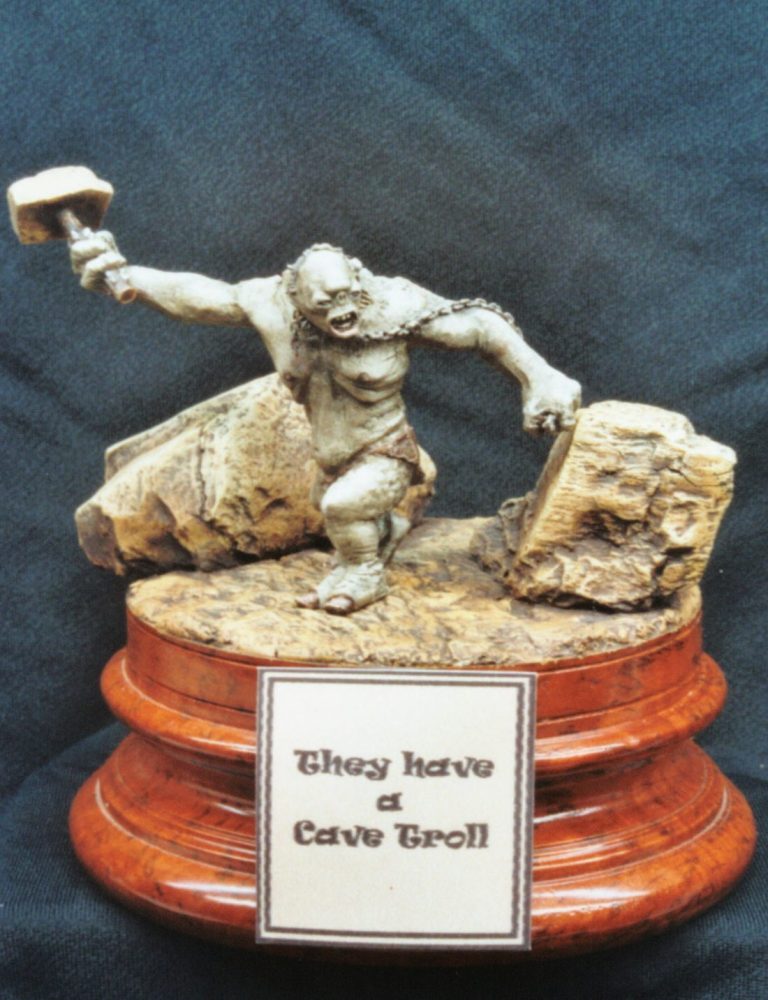
The eyes were painted in, Thomas using some Mars Brown and some Mars Black oils, me ( being a smart ass ), adding a tiny catchlight of Titanium White, once I’d done the above..
The teeth were painted with some off-white oils, and the tongues with a pinkish mix of the flesh colour that I’d got left over from another model.
Now for a base.
Thomas was going to use his for wargaming, and was therefore all set to add his model to the 40 x 40 plastic base, up until he saw what I was doing with mine.
Then for some apparent reason, and I must stress this; he didn’t copy me, but did something “quite similar” ( apparently that’s his excuse and he’s sticking to it ! ).
I picked a fairly large plinth from Armstrong Bases of Peterlee. It had to be quite big — about 150mm across, because whilst the model is quite short, his arm span is surprisingly big, especially with that hammer added.
To make the groundwork I spread a thin coating of Milliput onto the plinth, having scored the top of the wood with a knife so that the putty had something to grip onto; and then used a piece of rock to texture the Milliput.
I then added a couple of larger rocks to the sides of the base, hinting that there was a shattered tunnel opening behind the troll, through which he’d just squeezed. Whilst the putty was still soft, I drilled through it for the wires that I’d put into the troll’s feet, and then pressed him into place so that his feet left slight impressions in the putty. I then removed the model so that I could paint the base once the Milliput had hardened.
After masking the wood part of the base off, I painted the whole of the Milliput groundwork with some of the GW Ore Brown, adding this in three or four thin layers, and then left it to dry thoroughly. Then I added Burnt Umber Oil paint to the whole of the base, and once all the detail was covered, gently wiped and dabbed the excess paint off with an old T-shirt.
When the oil paint had dried, I drybrushed the upper areas and the places where theoretically orcs and people would tend to walk with some more of the Orc Brown and also some Orc Brown / Skull White mixed together for final highlights.
After that, the model was fastened in place, this time using superglue, because the wires I’d left on the model were 20mm long, and he wasn’t going anywhere with those in his feet, and then printed off a nameplate for the front of the plinth.
That was just about it.
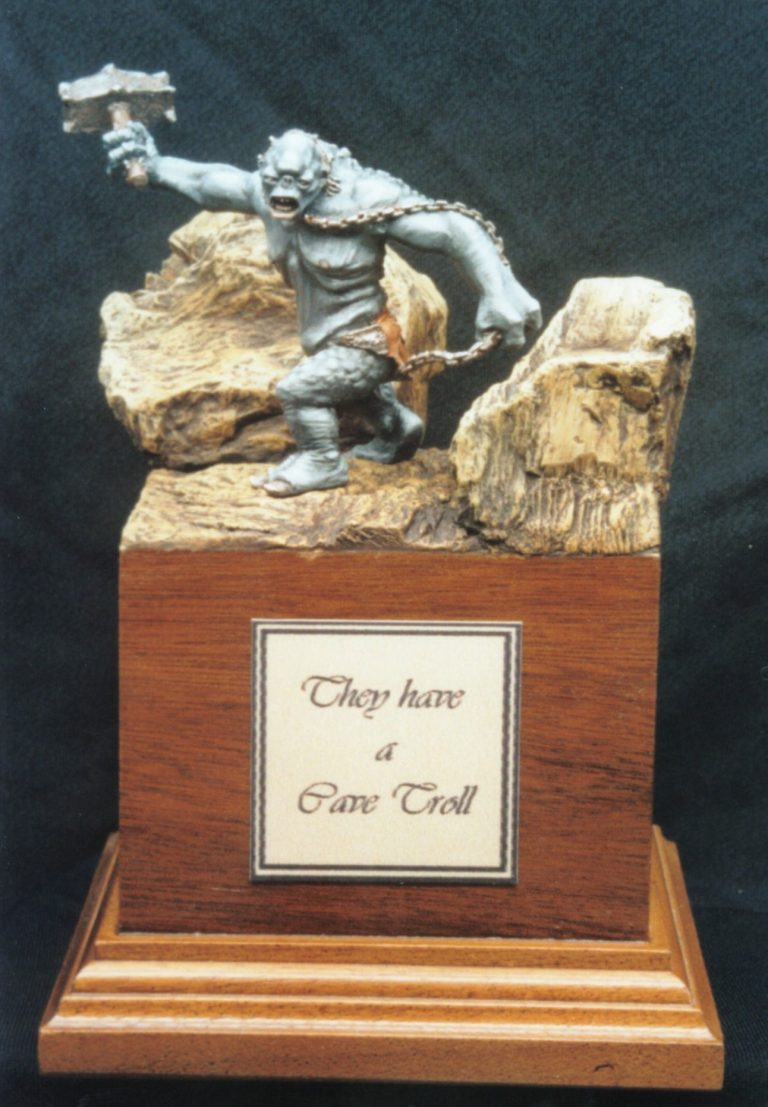

Verdict.
I don’t think either of us like the metal that GW is using. We recently got hold of some Rackham figures from Stormtroopers and also from Dave Armstrong’s Bases, and Rackham use the more traditional White Metal that is softer and easier to work with.
Apart from that though, these are good little models. They certainly look the part, and because the subject is mainly one colour, it’s quite easy to paint them effectively.
At ten pound each (and that’s when we bought them, so they might be more now ), they’re not too bad for value, although I’ve heard that prices have just been raised on some of GW’s ranges at the time that I’m writing this ( April 2005 )
Thomas has got a couple more of these Trolls, in different guises — the armoured one in particular springs to mind.
Having compared them, I think that this first version of the LOTR troll is the best. The armoured one seems to lack crispness, as the detail is somewhat soft. Maybe it’s because Thomas hasn’t put any paint on it yet, but the skin just doesn’t look finished to me.
Although I usually wax lyrical about GW stuff— the larger models particularly; with the amount of the smaller scale models that I possess, collected over the last twenty odd years, I tend to think that the golden years were in the mid 80’s when the likes of Kev Adams and John Blanche were sculpting stuff. The new stuff is good, but it hasn’t advanced as much as the military sculpting has in comparison.
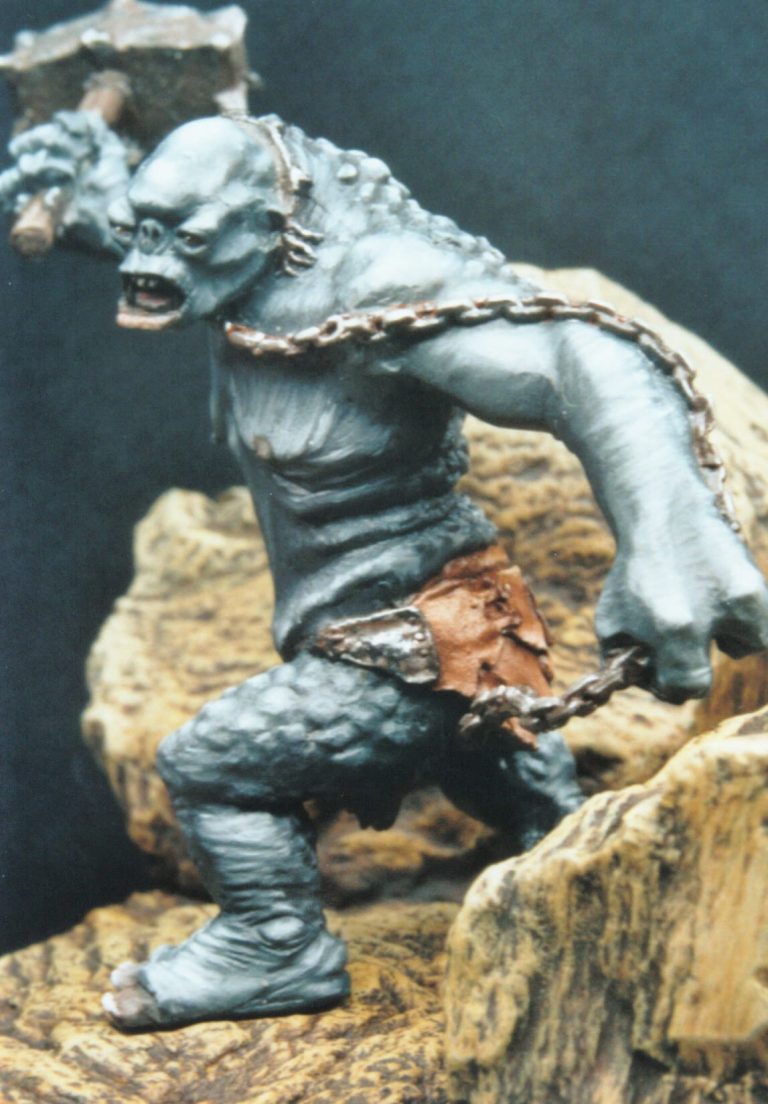
We need your consent to load the translations
We use a third-party service to translate the website content that may collect data about your activity. Please review the details in the privacy policy and accept the service to view the translations.